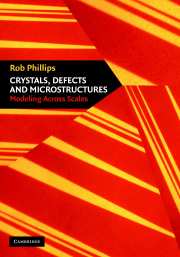Book contents
- Frontmatter
- Contents
- Preface
- Acknowledgements
- Notes on Units, Scales and Conventions
- Part One Thinking About the Material World
- Part two Energetics of Crystalline Solids
- Part three Geometric Structures in Solids: Defects and Microstructures
- 7 Point Defects in Solids
- 8 Line Defects in Solids
- 9 Wall Defects in Solids
- 10 Microstructure and its Evolution
- Part four Facing the Multiscale Challenge of Real Material Behavior
- References
- Index
10 - Microstructure and its Evolution
Published online by Cambridge University Press: 29 October 2009
- Frontmatter
- Contents
- Preface
- Acknowledgements
- Notes on Units, Scales and Conventions
- Part One Thinking About the Material World
- Part two Energetics of Crystalline Solids
- Part three Geometric Structures in Solids: Defects and Microstructures
- 7 Point Defects in Solids
- 8 Line Defects in Solids
- 9 Wall Defects in Solids
- 10 Microstructure and its Evolution
- Part four Facing the Multiscale Challenge of Real Material Behavior
- References
- Index
Summary
We have made no secret of the pivotal role played by various geometric structures within materials in conspiring to yield observed properties. However, one of the abiding themes of our work thus far has been the observation that this notion of ‘structure’ is complex and scale-dependent. The properties of materials depend upon geometry not only at the microscopic scale, but at larger scales as well. Recall that the hierarchy of geometric structures that populate materials begins with the underlying atomic arrangements. Questions of structure at this level are answered through an appeal to phase diagrams in the way considered in chap. 6. These atomic-level geometries are often disturbed by the various defects that have served as the centerpiece of the previous three chapters, and which introduce a next larger set of length scales in the hierarchy. However, much of the effort in effecting the structure–properties linkage in materials science is carried out at a larger scale yet, namely, that associated with the various microstructures within a material.
The current chapter has as its primary aim a discussion of some of the many types of microstructures that populate materials and how such microstructures and their temporal evolution can be captured from a theoretical perspective. This discussion will also serve as the basis of our later efforts to examine the connection between structure and properties in materials. We begin with an attempt at microstructural taxonomy with the aim being to give an idea of the various types of microstructures that arise in materials.
- Type
- Chapter
- Information
- Crystals, Defects and MicrostructuresModeling Across Scales, pp. 507 - 584Publisher: Cambridge University PressPrint publication year: 2001



